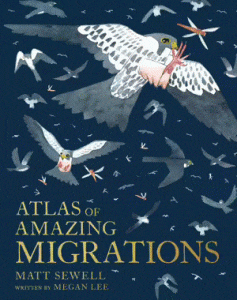
Atlas Of Amazing Migrations
Atlas Of Amazing Migrations
Megan Lee
Matt Sewell
Pavilion, 2021
160pp., hbk., RRP $A29.99
9781843654995
When Australians think of animal migrations, our thoughts tend to turn to the annual whale trails up and down are coasts as whales, particularly humpbacks, make their journeys from the cold, wintery waters of Antarctica to the warmth of the South Pacific to breed and give birth and then return to their rich feeding grounds of the south. To see these magnificent creatures “in the flesh” is a lifelong memory and on the bucket list of many.
But there are so many other creatures on this planet that also undertake amazing journeys in search of food or warmth or a mate (or all of the above) and this book, richly illustrated in watercolours by Matt Sewell, traces many of them whether they involve journeys of thousands of kilometres like the humpback, or just crossing the road, which can be treacherous if you’re a snake, or takes generations as is the case of the monarch butterfly. And even though those trips and treks can seem long and arduous, migration is in the genetic makeup and the creature is compelled to follow its instincts following magnetic fields, temperature and light as their navigation tools. Throughout the book there are maps of some of the routes taken showing the enormous distances travelled, leaving the reader in awe of the undertakings.
More for the independent reader with an interest in natural history, nevertheless the information is accessible, straight-forward and interesting, offering the opportunity to explore particular creatures of interest further. It is a great follow up for those wanting to know more after reading Tiny Possum and the Migrating Moths which explores the relationship between the rare mountain pygmy possum and its food source, the bogong moth and the impact that urbanisation has had on the moths’ migration.
It could also be a follow up tangent to any stories or units about the travels and journeys that the students have made, particularly as places start to open up again. Add a new dimension by having students think about their purpose for travel, the preparations they made, the navigation tools they used and so forth. Could take the ‘what I did/where I went in the holidays’ staple to a whole new level. What if they were the humpback whale or the corn leaf aphid?
So while we can and do celebrate the return of the humpbacks to our waters each year, this book teaches us that there are many who make journeys and who may also be in peril of more than a speeding car.